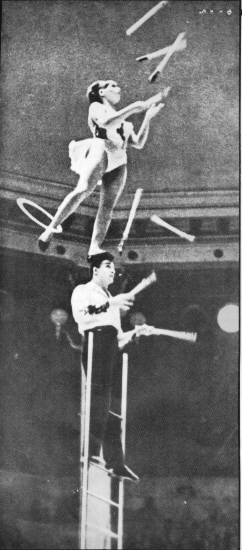
W. and S. Tscherniauskas on the free-standing ladder. (reprinted with permission from '4000 Years of Juggling') |
Page 16 December 1982
|
W German collector issues second volume on history of juggling By Gene Jones, IJA President
(Ed. note) A work of this magnitude is a rare occurrence in the juggling world and therefore warrants more than a casual review. To research this article, Gene Jones traveled to West Berlin after attending the European IJA Convention to interview the author, Karl-Heinz Zeithen, and then to Paris to talk with the publisher, Michel Poignant.
After
covering more than 3,900 years in Volume I, Karl-Heinz Zeithen has
dedicated the second volume of 4,000 Years of Juggling exclusively to
the 20th century.
This
attempt to bring juggling up to date represents the conclusion of a
flawed, though noble, effort.
Zeithen
begins Volume II by stating ". ..the juggling art still remains one
of the main genres of circus life and occupies, especially in
Volume
II appears to be Zeithen's evidence to substantiate this claim. The book
contains a plethora of brief biographies about exceptional jugglers of
this century. When accumulated within the covers of a single
publication, the number of accomplished jugglers and their respective
feats becomes astounding. It also becomes apparent that the vast
majority of eclectic juggling artists are of European origin. Mr.
Zeithen mourns the demise of the active cabaret and variety clubs that
existed before World War II, since they provided a major source of
employment for jugglers. Coupling that development with a sharp decrease
in the number of active circuses, Zeithen points out that there is no
longer a network of apprenticeship opportunity available for aspiring
jugglers to develop high level talents.
The
chapter "Club Juggling Troupes" discusses the growth and
dissolution of numerous European juggling families which supplied many
of the world's foremost solo artists during the past 30 years. Zeithen
singles out
Volume
II is at its best when Mr. Zeithen focuses on the details of a
particular artist's life and skills. One of the most striking examples
is the story of Spanish antipodist Tito Reyes.
Reyes
was stricken by polio at age four, causing him to lose his ability to
walk. His brother-in-law began burying him in the sand at the beach far
from home to force him to relearn walking. As a result, Reyes learned to
walk on his hands and developed "an unusual sense
of balance." He also learned to juggle, and eventually
developed an act that made him one of the leading head-antipodists of
the 1950s. |

W. and S. Tscherniauskas on the free-standing ladder. (reprinted with permission from '4000 Years of Juggling') |